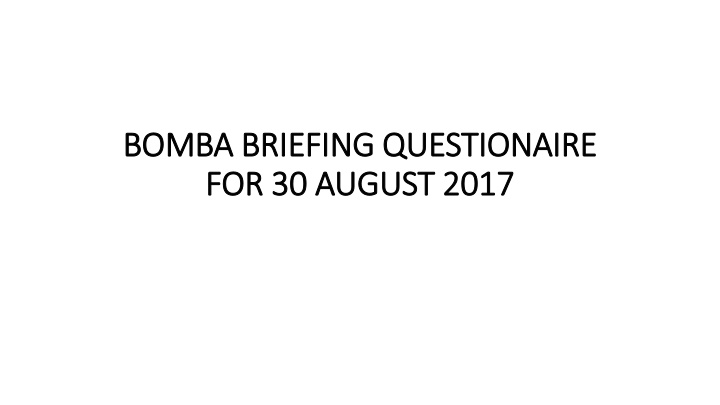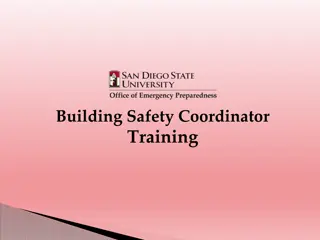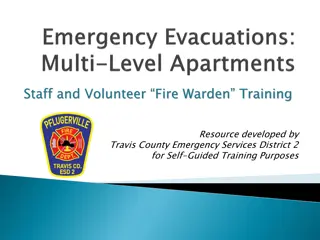Fire Safety Regulations and Building Access Guidelines
Understanding the requirements outlined in by-laws such as distance specifications for accessways, gradient limits for access roads, markings at corners, and travel distance measurements for different room occupancies. Clarification provided on various scenarios related to building access and fire safety compliance.
Download Presentation

Please find below an Image/Link to download the presentation.
The content on the website is provided AS IS for your information and personal use only. It may not be sold, licensed, or shared on other websites without obtaining consent from the author.If you encounter any issues during the download, it is possible that the publisher has removed the file from their server.
You are allowed to download the files provided on this website for personal or commercial use, subject to the condition that they are used lawfully. All files are the property of their respective owners.
The content on the website is provided AS IS for your information and personal use only. It may not be sold, licensed, or shared on other websites without obtaining consent from the author.
E N D
Presentation Transcript
BOMBA BRIEFING QUESTIONAIRE BOMBA BRIEFING QUESTIONAIRE FOR 30 AUGUST 2017 FOR 30 AUGUST 2017
By-law 140 : Fire appliances access (2) The requirements of accessway shall be as follows: (c)the accessway shall be positioned so that the nearer edge shall be not less than 2 metres or more than 10 metres from the centre position of the access opening, measured horizontally; Please clarify on the location of this 2m nearer edge / 10m from centre position. (d)the accessway shall be laid on a level platform or if on an incline, the gradient shall not exceed 1:15. The access road shall be laid on a incline not exceeding a gradient of 1:8.3:
For an island site bomba access requirement:- i) Does the accessway with gradient 1:15 applies throughtout the internal roads? or ii) Can the gradient 1:8.3 be applied for part of the internal roads where it is away from the hydrant? Please clarify the location of access way/road. ii) If an BP has been approved with 1:12 gradient previously, can the Amended BP that is to be submitted remain as 1:12 gradient as it may not be possible to change at this advance stage.
By-law 140 : Fire appliances access (2)(h) public roads may serve as accessway provided that the location of such public roads is in compliance with the requirements of distance from access openings as the Fire Authority may specify; and Please clarify what is the required distance from access opening. (3) All corners of the accessway shall be marked as follows: (a)the marking of corners shall be in contrasting colour to the ground surfaces or finishes: Please clarify what type of corner marking required.
By-law 165. (3)In any of individual room which is subjected to occupancy of not more than six persons, the travel distance shall be measured from the door of such room: Measurement of travel distance to exits. Provided that the area of the room does not exceed 15 square metres or any other area determined by the Fire Authority i) Does this applies only for commercial developments? ii)If Yes, what is the rationale of allowing only 15sqm? iii)If it also applies to residential units, does that mean that the maximum size of the living area and bedrooms is only 15sqm? Please clarify.
By-law 194 A single staircase may be permitted in the following premises: (a) Any dwellings at a height of 12 metres measured from the fire appliance access level to the highest and lowest floor; and Building with single staircase (b) Any shophouses or dwellings not exceeding two (2) storeys of the first storey not exceeding 6 metres from the ground level. Item (a) mentioned dwellings of 12m which is equivalent to 3 storey and item (b) also mentioned dwellings which is only allowed for 2 storey. These 2 clauses seem contracdicting. Please clarify
By-law 195 In building exceeding 30m in height, all staircases intended to be used as means of egress shall be carried to the roof level to give access thereto. Staircase to reach roof level What if the building was designed with pitch roof/ inclined roof which is not accessible? Please clarify whether we are required to bring the staircase landing to the pitch roof level.
By-law 197A 18.0 metres high (1)Buildings in which the topmost floor is more than 18.0 metres above fire appliance access level shall be provided with means of gaining access and fighting fire from within the building consisting of fire fighting access lobbies, fire fighting staircases, fire lifts and dry or wet rising systems. Means of access and fire fighting in building over Fire fighting access lobbies, fire fighting staircases, fire ifts and wet/dry risers are allowed in the fire fighting lobby; can hose reels also be located in the fire fighting lobby. If not, why?
By-law 199 not exceeding 3-storey or 18m In buildings not exceeding 3-storeys or 18m above ground level, staircase enclosures may be unventilated provided that access to them at all levels except the top floor is through ventilated lobbies and the staircase enclosures are permanently ventilated at the top with at least 5 % of the area of enclosures. Is it required to have a ventilated lobbies only at the top floor as permanent ventilation was provided at the end of staircase? Please clarify. Ventilation of staircase enclosures in buildings
3.Fire fighting access lobbies may be ommitted if the fire fighting staircase is pressurised to meet the requirements of by-law 200 and all fire fighting installations within the pressurised staircase enclosure do not intrude into the clear space required for means of egrees. i) Please elaborate how does the omission of the fire fighting lobbies works. ii)What if the fire fighting staircases are natural ventilated, can the fire fighting lobbies be omitted? iii)Does the fire fighting installation mentioned includes hose reel or only wet/dry risers?
Fire Safety Engineering: Performance Based Approach a) building? b) point/ between exit staircase to exit staircase with the installation of smoke spilled system and fresh air intake (Smoke Control). Please elaborate. What is the differences between PBA and UBBL designed PBA designed building allowed for longer travel distance to exit
(5) A fire lift shall be provided to give access to each fire fighting access lobby or in the absence of a lobby to the fire fighting staircase at each floor level. Please elaborate on how the fire lift access directly into the fire fighting staircases. Is it straight into the staircase landing area? Please clarify.
For apartments without open corridor, heat/smoke detectors are required at the corridor and lobby. Do we need to provide any heat/smoke detector in the apartment unit? Can a proprietary fire rated drywall be accepted as a fire compartment wall? If not, why? Can a fire lift have 2 openings. One opening to the guest lift lobby and the other one opening to the fire fighting lobby?
Tenth Schedule Note: Open Structure (1)Total surface area of opening is to be no less than 40% of the total perimeter wall area enclosing the floor or compartment, (2)The opening(s) is to be shaped and located in such a way that total length in plan of the opening(s) is to be no less than 50% of the perimeter of the floor or compartment.
Open Corridor (1)Total surface area of openings is to be no less than 25% of the total perimeter wall area enclosing the balcony. (2)The opening(s) is to be shaped and located in such a way that total length in plan of the opening(s) is to be no less than 50% of the perimeter of the balcony. Please clarify and illustrade how to apply this for compliance.
For high rise tower, under what circumstance can an open staircase without fire door be used? Please elaborate on the application of the Sixth Schedule calculations for compliances.
Clause Question Reply UBBL 197A. (1) Buildings in which the topmost floor is more than 18.0 meters above fire appliance access level shall be provided with means of gaining access and fighting fire from within the building consisting of fire fighting access lobbies, fire fighting staircases, fire lifts and dry or wet rising systems. & (2) Fire Fighting access lobbies shall be provided at every floor level and shall be so located that the level distance from the furthermost point of floor does not exceed 45.0 meters. & (10) Fire lifts shall be provided at the rate of one lift in every group of lifts which discharge into the same protected enclosure or smoke lobby containing the rising main, provided that the fire lifts are located not more than 61 meters travel distance from the furthermost point of the floor Does every Fire Fighting access lobby need to have Fire Lift? Is the distance coverage of the fire lift 45m or 61 m from furthermost point of floor? If the fire lift is located within a protected fire fighting lobby, is the distance of coverage measured from the fire lift door opening itself or from the fire rated access door into the protected lobby?
Clause Question Reply UBBL 197A. (1) Buildings in which the topmost floor is more than 18.0 meters above fire appliance access level shall be provided with means of gaining access and fighting fire from within the building consisting of fire fighting access lobbies, fire fighting staircases, fire lifts and dry or wet rising systems. & (7) In a building where the top occupied floor is over 18.5 meters above the fire appliance access level fire lifts shall be provided. For fire lift, do we need to include it when the building is 18 meters above fire appliance access or 18.5 meters above fire appliance access? For a building which the ground floor platform is elevated from the external road level (e.g. elevated 1m above external road), can the fire lift land on the elevated ground floor platform and connect to the road level via steps? Or does the fire lift need to land on a platform levelled with the external road? General Question In regards to Fire Lift Home Landing Level
Clause Question Reply UBBL Clause 251. Smoke control systems where specified shall be designed and installed in accordance with MS 1780 MS 1780 Clause 8.8.21 Smoke ventilation ducts (both exhaust and replacement air ducts) passing through another fire compartment shall be constructed to have the same rating and / or as that of the compartment. If the smoke ventilation ducts (both exhaust and replacement air ducts) did not pass through another fire compartment, is 1.2mm thick G.I. smoke ventilation duct without fire resistant material, i.e. fire resistant paint, etc. acceptable?























